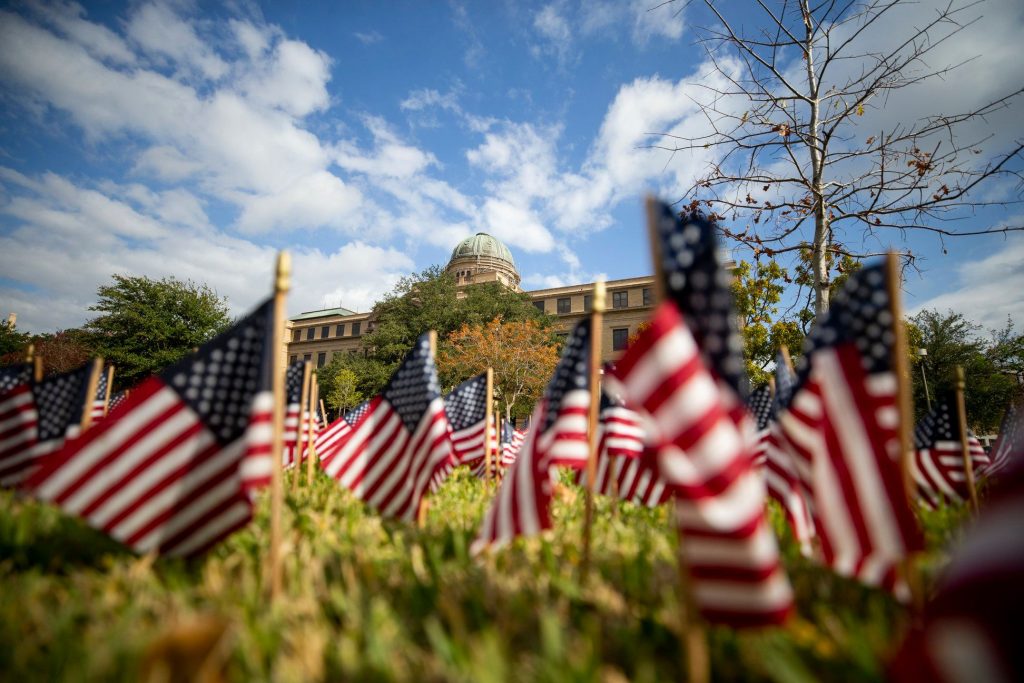Texas A&M Researcher Helps Improve Veteran Support in Texas
Nandita Chaudhuri, research scientist in the college’s Public Policy Research Institute, conducted research that’s being used by policy makers to improve services offered to Texas veterans.

By Rachel Knight ‘18
Nandita Chaudhuri, a research scientist in the college’s Public Policy Research Institute (PPRI), conducted research that is laying the foundation for better veteran support in the state of Texas.
Both Chaudhuri’s research team and the Texas Veterans Commission (TVC), the organization that funded this research with a $153,555 grant, were surprised by some of their findings.
TVC’s mission is to provide superior service to veterans that significantly improves their quality of life. Currently, they award grants called Funds for Veteran Assistance (FVAs) to veteran serving organizations in eight different regions of Texas. Chaudhuri’s research team consisted of PPRI staff with expertise in survey research and focus group techniques: Kirby Goidel, Marina Brandman, Lisa Halperin, Anthony Jackson, Ashleigh Williams, and Zack Brattin. State-wide surveys of veterans and veteran serving organizations, asset mapping and focus groups of veterans from across the state conducted by Chaudhuri’s team suggested that healthcare support is the greatest service needed for the Texas veterans, no matter the region.
“This was a surprise for TVC, because they do not have a grant area that directly connects with healthcare support” Chaudhuri explained. “They don’t have a grant in this area but they do have a department that helps Texas veterans navigate [Veterans Administration] VA’s healthcare setting. A key recommendation from the study is that TVC might want to consider adding a new grant area that focuses on healthcare support for Texas veterans and carefully define the boundaries for this grant area with systematic feedback and open communication with key stakeholders.”
Through a series of 17 focus groups, Chaudhuri and her team learned that to Texas veterans “healthcare support” means help accessing and navigating their VA healthcare options, support with care coordination and healthcare access. The focus groups also revealed that most Texas veterans did not know that TVC offers assistance to navigate the VA healthcare system.
“Most of the focus group participants told us that they get their healthcare information from other veterans, friends, and family members, rather than the TVC or even the VA,” Chauduri explained. “So really they only find out about services that are available if someone they know has also needed them. When they separate from the military and are transitioning to civilian life, they don’t have much help or anyone telling them what services are available to them. This leads to a lot of frustration that we heard from the Texas veterans.”
This finding made TVC’s investment in Chaudhuri’s research invaluable to both TVC and the veterans they aim to serve. Chaudhuri’s final report is available to the public, because the work is mandated by the state legislature. This means her team’s research can be used by veteran serving entities everywhere to inform improvements to their services. Based on the study findings presented to TVC commissioners and legislative committees, TVC argued for more health care advocates to improve access to health care for veterans across the state.
“Another recommendation is for TVC to pay attention to some of the marketing and outreach strategies the veterans suggested,” Chaudhuri shared. “They recommended using a combination of various marketing outlets and strategies, including not only social media but also sending mass emails, conducting veterans’ town hall meetings, using faith-based organizations, installing billboards in largely populated areas, sending mailers in utility bills, and interviewing TVC staff to discuss service availability on local radio shows.”
While largely populated areas could benefit from mass media approaches, Chaudhuri’s research team also heard from veterans living in rural areas that print media would be a more effective marketing tool in rural Texas. Both in rural and urban areas, an inadequate understanding of benefits and not knowing where to obtain help were amongst the top barriers for veterans to obtain services and this is where targeted marketing and outreach could be valuable.
“Especially in the rural areas, veterans get their news from the local newspapers. It’s very important for them because it runs local stories,” Chaudhuri said. “TVC has to pay attention to the fact that they can’t use social media to reach veterans in rural areas who don’t have easy access to it.”
Other findings from Chaudhuri’s research suggest that the emotional and psychological needs of the veteran population are more profound than in the general public.
“Many of them said again and again that unless you address the mental health needs, all these other benefits you provide in different regions are of no use at all,” she explained.
Chaudhuri’s research team also learned that the needs of women veterans require special attention. Both male and female veterans told the research team that women veterans face a unique set of challenges. Future research should focus on the unique needs of women veterans as a separate study, Chaudhuri said.
TVC is now using the PPRI team’s findings to inform their grants based resource allocation and policies, thus improving the services offered to the Texas veterans in all eight FVA (Funds for Veterans Assistance) regions.
“I feel blessed that I can use my social science background in comparative public policy and complex social program evaluations to help inform allocation of resources and policies,” Chaudhuri shared. “Projects like this allow me to use my professional training to improve the state’s services for the people who serve our country.”
